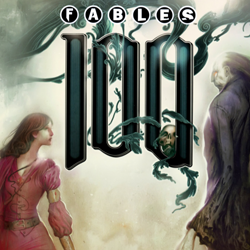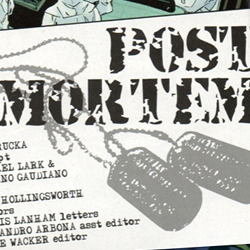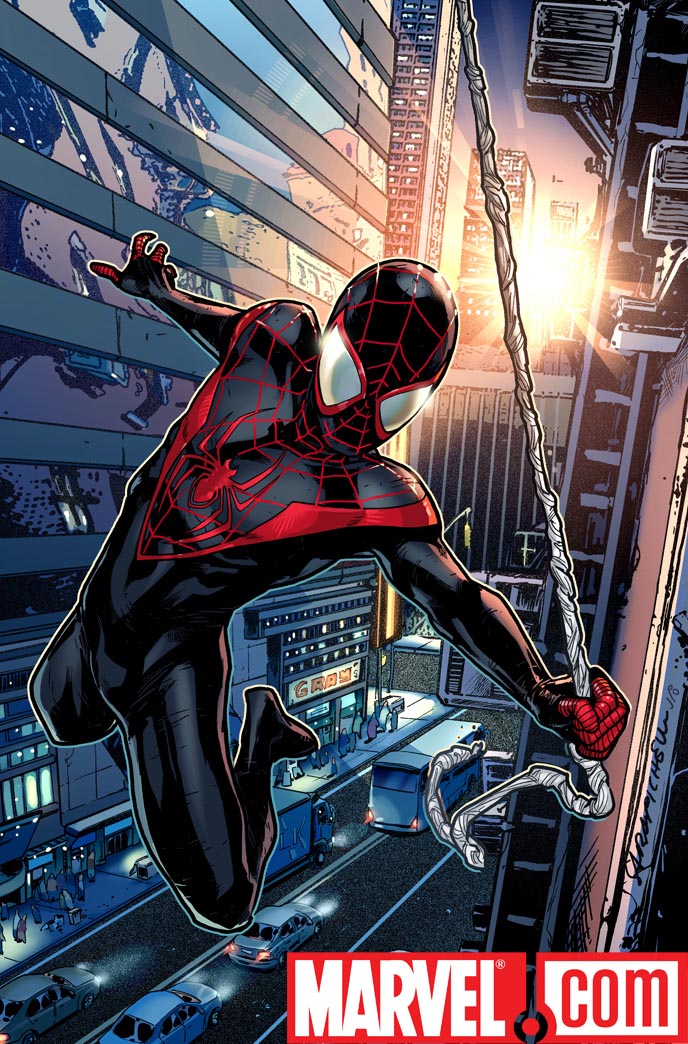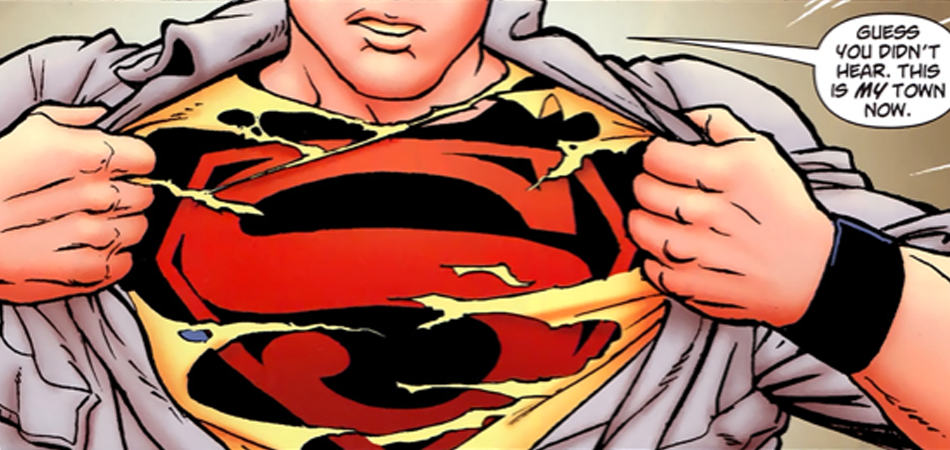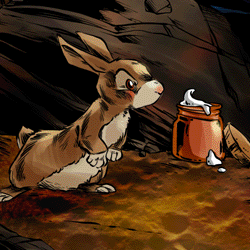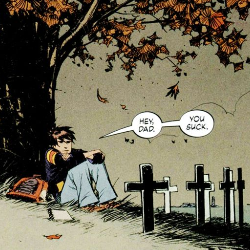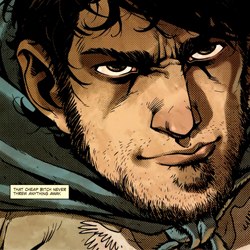Fables Issue 100
Nominated for a Will Eisner Comic Industry Award in the Best Single Issue (or One-Shot) category, “Fables” issue 100 was the first title I read that I simply did not feel belonged on the list of nominees. I will readily admit to not having read any prior issues, however I do not believe that had any impact on my decision. Based on the fact that the series contains existing (well-known) characters, as well as the fact that it was nominated as a single issue, I feel that a sound opinion can be made having only just read this issue. “Fables” issue 100 contains several short pieces, as well as a puppet theater. Yes, you read that correctly. Here is a complete list of the contents: • Single Combat • Pinocchio’s Army • The Fables Paper Puppet Theatre • The Perils of Thumbelina • Celebrity Burning Questions • A Thing With Those Mice • Escape to Wolf Manor The issue begins with a lovely image of Three Blind Mice discussing the definition of the word “duel”, setting up the first, and main, story. The mice break the fourth barrier in this single panel, by making reference to the “issue” that they are in. “Single Combat” is written by Bill Willingham, pencilled by Mark Buckingham, inked by Steve Leialoha and Andrew Pepoy and finally colored by Lee Loughridge. One would think that with so many people working on it, I would be more impressed. However, I am not. I’ll get to the story shortly, however in terms of the art, I must admit to being completely underwhelmed. Perhaps it was their intent to recreate a style reminiscent of old fable comics from decades ago, however I wasn’t a fan of that style then, and that opinion has not changed. The story contains several concurrent plot-lines, and though they converge at points, I still found the manner in which they were handled somewhat clumsy. The main part of the short story of course is the battle between the witch, Frau Totenkinder, and Mister Dark. Having once been contained within a box in issues prior, Mister Dark was unwittingly set free. Totenkinder intends to contain him again. The battle between the two is full of conjurations, be they shadows, boxes or fish (yes… fish), shapeshifting, and the likes. If you were reading this to a child, perhaps they would be entertained by Mister Dark being force fed sugar in such large amounts that it causes his teeth to fall out, however an adult may be far less interested. In the end, Totenkinder transmutes thousands of gold pieces into an armor meant to contain Mister Dark. Seeing as he is allergic to gold, it seems the smartest type of box to use. Would that this had been the true focus of the story, perhaps it would not have felt so disjointed. However during this fight, we have pages which flash to Fabletown, where the fight is being announced and discussed; we see “real” police in New York City preparing to take action if the fight spills outside of the old Fabletown area; and we’ve the sheriff’s wife who is having labor complications… not to mention the altercations with Nurse Spratt. Even when you think it’s all done, cracks begin to appear and Fabletown is turned on its head once more. Sadly, I just did not enjoy this story at all. Having spent countless hours reading fables to my children, I can honestly say that I’ve no prejudice against this type of story. However, they must be properly told, and in this case, I simply do not feel they were. Next we have the short story, “Pinocchio’s Army” which spans eight pages. It is written by Mark Buckingham with several illustrations by Bill Willingham. With lines like; “(Pinocchio) hew that Internet porn and an expresso machine were things he would have to live without for now”, you are not likely to read this story to your children any time soon. The story sees Geppetto’s creations (children) worried about the old man. He has grown quite sullen, and it is up to Pinocchio to cheer him up, which he does by presenting him with a suitcase full of toy soldiers, which Geppetto had once crafted years before. Once again, I’ve a problem with the writing in this short story. This may simply be a personal preference, however I found it far too descriptive. When you are limited by a restrictive word count, you don’t want to waste paragraphs setting the stage, when instead you can be furthering the story. Also, I found Buckingham’s pace extremely slow at times. For a story this short, I should have been able to easily read it through in one sitting, however I found myself “zoning” out often, and it took several readings for me to actually finish it. After this short story, we find the Puppet Theatre, where readers are encouraged to cut shapes out of the comic book. /gasp Seriously. I would not even advise a child to do this. I know what they are trying to do here, but dear lord… cutting into a comic book?!? “The Perils of Thumbelina“, written by Bill Willingham, with art by Chrissie Zullo, is a complete and utter waste of three pages. The vignette shows a boy trying to ask Thumbelina out on a date, only to have a hawk (or falcon) drop from the sky and grasp her in its talons. As she is being whisked away, she says; “Well… this is certainly turning out to be a lovely day”. No. Really. I’m not making this up. As disappointing as that was, it paled in comparison to the illustrated answers to reader questions, such as; Who makes the Fabletown comic books; Can I have Snow White’s phone number, and; Now that Baba Yaga is dead, how is Bufkin passing the time? The only story which I found mildly amusing was the last one; “A Thing With Those Mice“, also written by Bill Willingham, with art by Joao Ruas. As a point of interest, Ruas’ art is absolutely stunning, as opposed to most of the art in this issue. The vignette is quite simple, which is hardly a surprise. It depicts the Three Blind Mice who are on their way to see the King, in order to receive their knighthoods… among other things. They, of course, get lost and proceed to walk into the open mouth of a beast… whom you find out will in fact spit them out once he’s had a bit of “fun with them”. There’s really not much else to say. The issue ends with a board game entitled; Escape to Wolf Manor… yet another example of the writers misunderstanding the medium. Comic books are meant to be read, not cut apart and played upon. Some argue that this issue is meant for children, who are more likely to want to decimate their comic books for the sake of a few quaint moments with a puppet theatre. However to those I would argue, if this issue truly were meant for children, there would be no mention of pornography by Pinocchio, nor bestiality by Lily Martagon in the reader questions. I just don’t understand why this issue was nominated for an Eisner. In and of itself, it is not a good issue. I don’t feel it is deserving of a high review score, let alone an Eisner nomination. When compared to “The Cape“, I fail to see what was going through the judges’ minds when they agreed to give “Fables” issue 100 a nomination. I only hope it does not win, as that would be an insult to all the other nominees. “Fables” Issue 100 Vertigo/DC Stories: Bill Willingham, Mark Buckingham Art: Bill Willingham, Mark Buckingham, Dan Green, Lee Loughridge, Joao Ruas and others...
